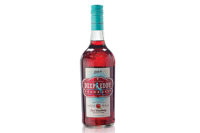Beverage labels help brands connect with consumers
Sustainability, premiumization drive labeling material innovations

Image courtesy of Zing Zang
Media personality, businesswoman and socialite Paris Hilton first attracted tabloid attention in the late 1990s for her presence in NYC’s social scene. Today, Hilton, who still gains attention for her media ventures and projects, is quoted for saying: “I travel around the world constantly promoting my projects and endorsing products. Yes, I do get paid to go to parties — in fact, I’m the person who started the whole trend of paid appearances. But when you see me at a party, I’m always working or promoting something.”
Similar to Hilton, beverage manufacturers continuously are looking for ways to promote their brands and products. As such, the materials used to create packaging labels play a major role in helping their drinks stand out from the crowd.
“Beverage-makers are increasingly seeking label enhancements to differentiate their products on the shelf,” says Vanita Marzette, senior product manager at Mentor, Ohio-based Avery Dennison. “Metallized film materials offer a stunning aesthetic appeal that beverage-makers are adopting to set their products apart on the shelves.
“Embossing that shows a pattern that makes the brand look distinctive or brings out the shape of design elements — spot varnishing that can help spotlight certain design elements, foiling, hot and cold foiling that adds a detail and shimmer when combined with an over-laminate — these materials not only enhance the visual appeal but also ensure durability, keeping labels looking fresh for an extended period,” she continues.
Marzette also notes the increased demand for thicker, more textured papers.
“In alcoholic beverages, wine and spirits specifically, premiumization continues to be a strong trend,” she explains. “There are more and more brands entering into this space and they want to stand out from the crowd. They are using thicker— 70 plus pound — material, enhancing designs with embossing patterns, foiling and other printing techniques. They are also using unique materials like velvet, cotton and hemp to enhance their look and brand story while still incorporating recycled content in the label stock.”
Aside from the demand for aesthetically pleasing labels, Marzette notes that, with a heightened focus on health and wellness, labels now need to provide clear, easily readable information about nutritional content and ingredients.
“Furthermore, the rise in popularity of ready-to-drink beverages and single-serve packaging necessitates labels that can withstand various storage conditions, including refrigeration and moisture,” she says.
Yet, across all beverage segments the demand for sustainable and recyclable materials are having a major impact on labeling materials.
“Brands are pushing for sustainable materials and then are highlighting these sustainability efforts in the brands label design,” Marzette says. “Our AD CleanFlake film portfolio helps beverage brands stand out on the shelf all while enabling recycling for PET and HDPE bottles.
“Many companies, like Avery Dennison, are prioritizing label materials that advance circularity and work towards a more sustainable future,” she continues. “Due to changing regulations and consumers demanding that the brands they buy are kinder to the environment/sustainable we see the demand for label materials with recycled content or labels that enable plastic recycling. There has also been a rise in requests for post-consumer/industrial waste material, organic and compostable materials.”
As far as what to consider when selecting labeling materials, Marzette points to the label’s aesthetics as well as the ability to maintain its integrity under various conditions.
“Adhesion is critical, as the label must adhere well to the packaging material and maintain its integrity under various conditions such as water (and ice bucket/cold box), oils, and other substances they may encounter,” she explains. ”Aesthetics play a role in complementing the overall design and branding strategy. Sustainability is increasingly a key factor, as eco-friendly options can enhance brand reputation and appeal to environmentally conscious consumers.”
Looking ahead, Marzette says that the future of labeling materials is promising, with several exciting advancements on the horizon.
“Smart labels, incorporating RFID or QR codes, can provide interactive experiences and detailed product information. Continued development of sustainable and recycled materials will further reduce environmental impact,” she concludes.
Looking for a reprint of this article?
From high-res PDFs to custom plaques, order your copy today!








